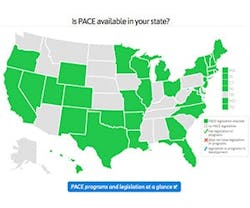If you haven’t heard about Property Assessed Clean Energy (PACE) financing, it’s a valuable resource you may be overlooking. Over the past few years, this new energy efficiency financing mechanism has swept across the U.S., with already more than half of the states approving legislation to enable it locally.
The PACE concept essentially involves financing energy efficiency projects via property tax assessments, which are repaid over longer periods than traditional credit-based loans. In simple terms, a project can be completely financed such that there is no initial capital expenditure. The loan is secured with a slight increase to the property tax payments.
Similar to performance contracting financing, the annual savings of the energy project are greater than the finance payments, so PACE is a cash flow neutral option for commercial properties. An exciting benefit of PACE is that it allows owners to take advantage of more capital-intensive projects with longer paybacks and greater overall savings. Because the repayment is tied to the property (and not the owner), PACE financing effectively reduces the vulnerability of traditional financing, which is primary influenced by the credit rating of the facility owner.
If the owner sells the property, the additional property tax obligation transfers with the property, but so do the energy savings (which are greater than the additional property taxes). Thus, after the retrofits, the improved property has a greater value.
Where is PACE Available?
Because state and local entities are involved, legislation to enable PACE financing has to be approved on a state basis. To see if PACE has been enabled in your map, see the map. The good news is that most states have already recognized the value in PACE and approved it. PACE represents a competitive advantage to the states that have enabled it, because businesses within those states have more ability to become cost-competitive via the positive cash flow from the energy efficiency projects.PageBreak
If your state does not have PACE enabled, visit www.PaceNow.org for a wealth of resources to help you get it passed in your state. They include webinars, training, templates, and educational resources such as case studies. These helpful documents and best practices are updated by many parties, including financing companies that have good incentive to enable more projects with reduced risk and long-term investment.
Overall, the process is a win-win. Financing companies have the political and economic connections and leverage to push legislation through state governments, which may seem like a daunting task for an individual facility manager.
As with performance contracts, the measurement of savings verifies progress for all parties. By using the International Performance Measurement and Verification Protocol (IPMVP) or guidelines from ASHRAE or ASTM, the performance of the building before and after retrofits can be confirmed in a way that is fair to all involved.
Of course, there will be some bumps in the road. Similar to performance contracts, sometimes projects can go bad due to unforeseen circumstances such as bankruptcies. However, most projects should meet financial goals and go fine.
Considering that most of U.S. buildings were constructed prior to 1990, there are many that are limited by their design and infrastructure to take advantage of newer, more efficient technologies. At these sites, the costs to enable a facility to accept new technologies may lengthen a payback beyond 5 years, which could kill the project. PACE’s long-term approach allows the owner to tackle lengthy paybacks and get projects implemented.
By mitigating an owner’s financial hurdles, PACE helps buildings over the long term, and we all need to be thinking long-term in regards to energy, financial resources, and the environment.
